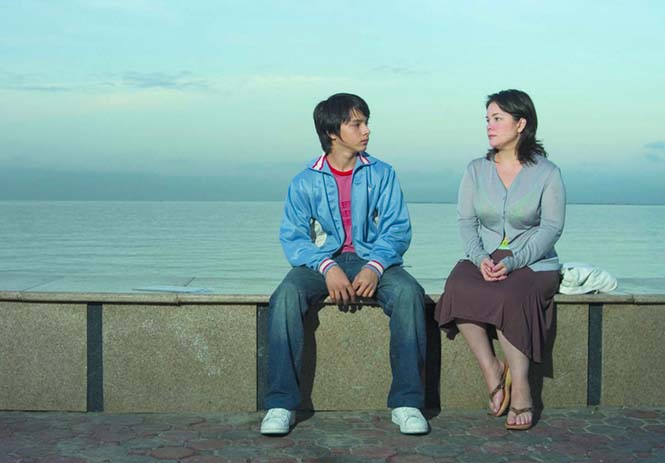Ran Öz and Johannes Frick, two queer artists from different countries (i.e. Israel and Germany) have yet to physically meet when they decided to artistically collaborate to delve into the difficulty of making new connections in the time of COVID-19.
“We want(ed) to take the audience on a gay, curious, emotional journey in a modern queer Pyramus and Thisbe dating experience: separated by a wall of 3500 km air, connected by a whole in form of a mobile phone screen,” both said.
The collaboration was actually Ran’s idea, said Johannes, with Ran asking a common friend whether she knew any queer German artists who might like to collaborate with him for the People to People Playground Festival of German-Israeli Future Found.
They then “met” on Zoom, where ideas/concepts were shared.
And then they eventually settled on a performance art (i.e. dating via Instagram live) “about making connections in these absurd times,” Ran said, adding that dating was a big part of the lives of gay people… until COVID-19, so that it would be interesting for others to “see themselves through us… of what we are going to go through (and) anything can happen.”
The duo, basically, wanted to probe the still-existing question: Can you create intimacy with a stranger through the virtual space?
This, then, is a “gay, curious, emotional journey in a modern queer Pyramus and Thisbe dating experience: separated by a wall of 3,500 kilometer air, but connected by a mobile phone screen.”
QUEER IN ART
This is the first time Ran collaborated; though – for Johannes – it is “just” the first time to collaborate with Ran ((e.g. in the past, he also worked with Jasmin Schädler to create a concert performance piece dealing with HIV and AIDS historically).
With this, both bring different “things” to this partnership.
To start, “I think, mostly, we bring ourselves, our openness to everything that could happen, and our baggage with us… like basically everything we’ve been through, the situation we’re in, and where we want to go,” Johannes said.
Ran aded, with a smile: ” I think… I bring humor, intelect, and sexiness; while Johannes, in my opinion, brings his charming personality, sweetness, and hotness.”
They agree, nonetheless, that being queer/non-binary artists play a role in their art.
This was the reason for their connection (as Johannes said), though also “this plays a role because the collaboration is about the connection between us, and we are both queers, so it’s part of each others’ story, and part of our story together.”
Johannes, incidentally, is a great fan of Marina Abramovic, Matthew Barney, and Arca’s performance work and music. “I think the inspiration for (my work with Ran), at least for me, might be my work with Falk Richter, a German theater author and director working internationally; and my work with Thomas Bo Nilsson. With Nilsson, I understood the beauty of virtually accessible shows that create great intimacy with the audience, live and online, while Richter inspired me to look for stories in my personal life and create art with them.”
Ran, meanwhile, was inspired by Andy Warhol’s film ‘Sleep’ (1964). For their performance, for example, the date lasted for 12 hours, ‘which – for me – was inspired by ‘Sleep’, a six-hour movie of a man who sleeps, finding the interesting things in the nothing. I guess that our date (i.e. the performance art with Johannes) has moments of emptiness; and for me, these are the moments when you are just being there, present, and that is the most interesting moments.”
ART AT THE TIME OF COVID-19
COVID-19 has, definitely affected arts. But – arguably – there’s an additional layer due to any artist’s SOGIESC.
“I think it is generally challenging to be an artist, even more so if you’re non-binary/queer,” said Johannes. “You’re facing the every day struggle of ‘How am I going to pay the rent next month?’ and ‘How can I improve my work?’. But if you’re non-binary/queer, you’re also challenged with judgement from family or society.”
For Johannes, “COVID-19 didn’t really make these issues easier, as performing has become very difficult in general in these times. I personally deal with these challenges by keeping my mind clear of negative thoughts as much as I can, and coming up with my own projects. My work in general makes me very happy and so I try to focus on it as much as I can.”
Ran added: “I face challenges regardless of COVID-19. The big challenge (with) COVID-19 for any artist was how to get money when you can’t work. By being a non-binary artist in Israel, I would say that the big challenge I’m going to face is finding audience to my works.”
ARTS & SOCIAL ISSUES
For Johanne, art push for social issues – e.g. gender identity (and other lGBTQIA issues), COVID-19, etc.
“Every public action has a political side to it. So by living out your gender identity, sharing your ideas and thoughts, you contribute to the public discussion and push the gender discourse or any important issue into focus,” he said.
Nonetheless, “of course art can be apolitical as well. But if you stay true to yourself and speak your mind, you will work with all the other incredible people to build the society you want to live in,” Johannes added.
And so for him, “art that conveys political messages is interesting art. Of course it is difficult to say whether art in general can push social issues but I believe history has taught us that it can at least mirror societies’ failures and achievements and therefore be part of the discussion and contribute in its own way.”
In the end, said Ran, “art is all about asking questions, pushing the limits of yourself and society, and going to new places both intellectually and emotionally. Therefore, just the fact that you are dealing with gender identity on your artworks, and bringing these voices to be heard are already challenging our society’s old norms by pushing these issues.”


























































































